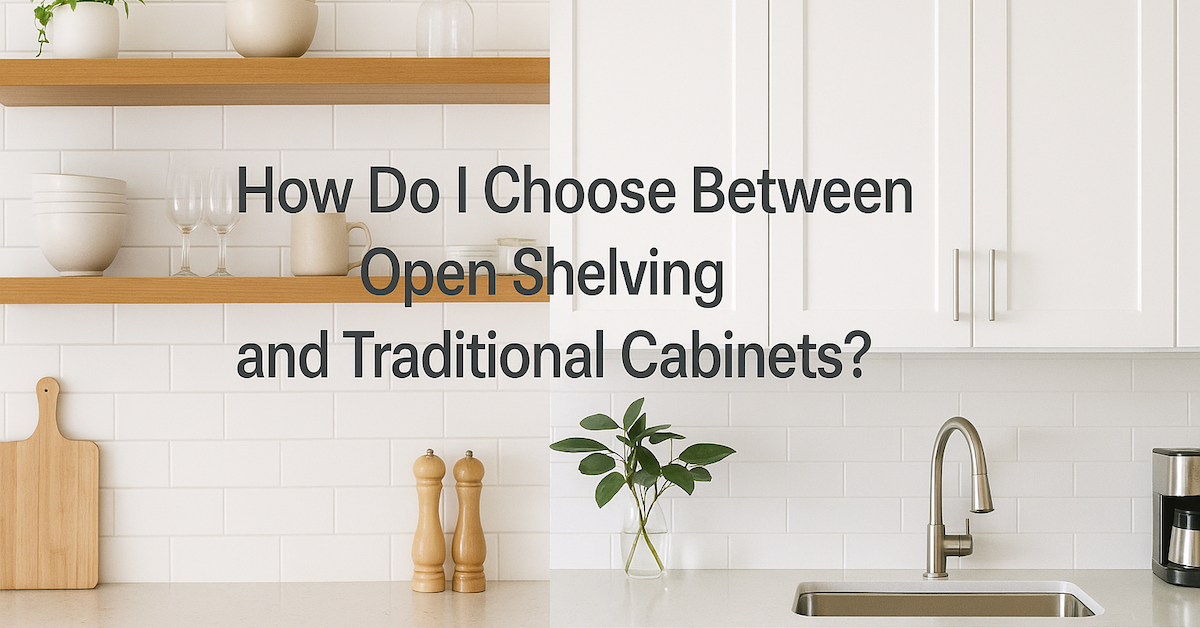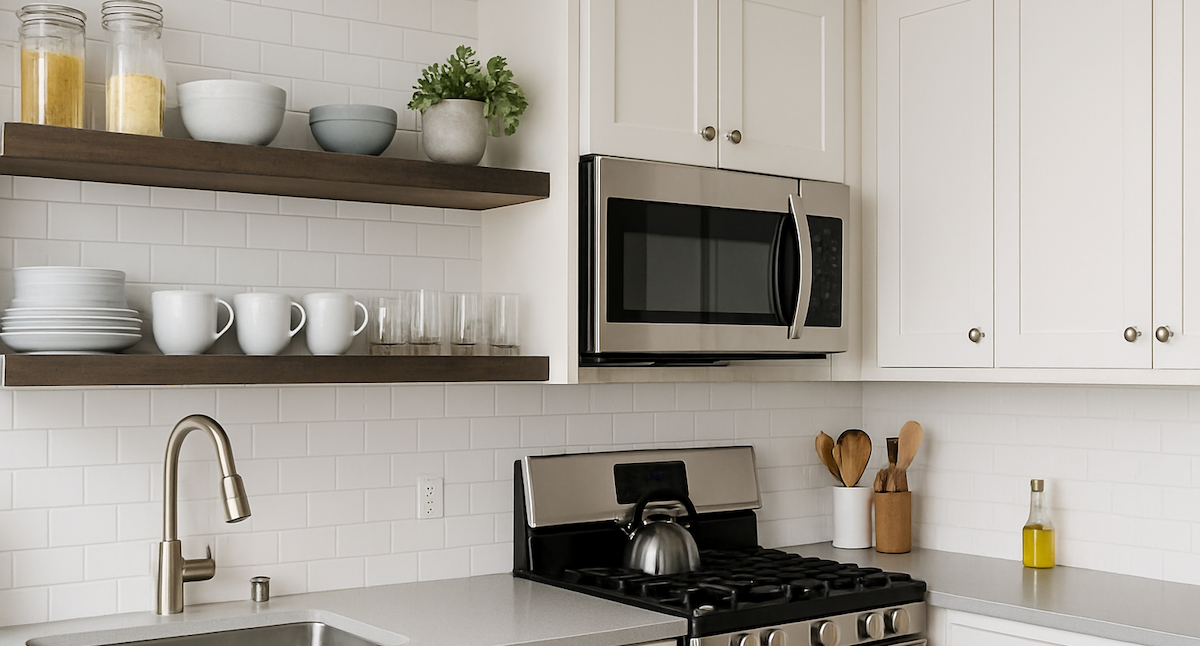How Do I Choose Between Open Shelving and Traditional Cabinets?
Designing a kitchen means balancing style, storage, and daily habits. The choice between open shelving and traditional cabinets is one of the most visible decisions you will make. Both options can look beautiful and work well if you match them to your space and lifestyle. In this guide you will learn what each option offers, where they shine, where they fall short, and how to combine them for a kitchen that feels organized, personal, and easy to maintain.

What Is Open Shelving?
Open shelving uses exposed shelves instead of closed cabinet boxes and doors. It creates a light, airy look that keeps everyday items within reach. You can install floating shelves, bracketed shelves, or rail systems. The focus is on display, quick access, and visual openness.
Benefits of Open Shelving
Open shelves can make a small kitchen feel larger because there are fewer visual barriers. You can see plates, glasses, and bowls at a glance, which speeds up cooking and cleanup. Shelves also add personality. Colorful dishes, plants, and cookbooks bring life to the walls and help the kitchen blend with nearby living spaces.
Drawbacks of Open Shelving
Open shelves collect dust and grease faster than closed storage. They require regular wiping and careful curation to avoid a cluttered look. Heavy items like small appliances or stacks of cookware may be better in closed storage for safety and support. If you prefer a minimalist look or dislike constant organizing, open shelves may feel high maintenance.
What Are Traditional Cabinets?
Traditional cabinets are enclosed storage with doors and drawers. They hide visual clutter, protect items from dust, and maximize vertical and corner space with inserts and pullouts. They can be framed or frameless, with endless door styles and finishes to match any kitchen design.

Benefits of Traditional Cabinets
Cabinets store more and hide more. You can tuck away mismatched cups, pantry goods, and cookware, which keeps the kitchen looking tidy. Full-height cabinets and deep drawers increase capacity and make it easier to organize heavy items. Soft-close hinges, dividers, and rollouts create a quiet, efficient workspace that is easy to live with.
Drawbacks of Traditional Cabinets
Cabinets can make a small kitchen feel enclosed if every wall is solid with doors. They also cost more per linear foot than simple shelving. Without glass fronts or open sections, you lose the chance to display style pieces that add character to the room.
How Kitchen Size and Layout Shape the Choice
In compact or galley kitchens, open shelving on one wall can remove visual weight and improve sightlines. It can also reduce cost when you need fewer cabinet boxes. In larger or U shaped kitchens, a full run of cabinets often makes more sense because you gain storage without sacrificing light or flow. If your range sits on a narrow wall, choose closed cabinets next to the cooktop and place open shelves on a cleaner wall away from splatter.
How Lifestyle and Cooking Habits Influence the Decision
Choose open shelving if you cook often and use the same dishes every day. Open shelves keep daily essentials at arm’s reach and speed up your routine. Choose traditional cabinets if you batch cook, own many appliances, or prefer to keep surfaces clear. If you have young kids or pets, closed storage helps keep fragile and heavy items safe.
Design Preferences and Visual Impact
Open shelves work well with modern, Scandinavian, and farmhouse styles because they highlight simple lines, wood tones, and bright dishware. Traditional cabinets suit classic and transitional kitchens that use detailed door styles, rich finishes, and layered lighting. If you like the openness of shelving but want a cleaner look, use glass front doors. They lighten the wall while protecting the contents.
Maintenance and Cleaning Considerations
Open shelves need weekly dusting in most homes. Items near a range or oven need more frequent cleaning. Select wipeable materials such as sealed wood, laminate, or metal. For cabinets, choose durable paints or laminates with easy clean finishes. Install quality hardware so doors and drawers stay aligned and quiet. Add liners in drawers to protect finishes and make cleanup simple.
Budget and Installation Factors
Open shelving can save money on cabinet boxes and doors, but strong brackets, solid wood, or custom floating hardware still add cost. You may also invest in new dishware for display. Cabinets cost more upfront but deliver long term function. If you plan to sell your home soon, buyers often expect ample cabinet storage, which supports resale value. A balanced plan can protect your budget while delivering the look you want.
Can You Mix Open Shelves and Cabinets?
Yes. Many well designed kitchens blend the two. A common approach is closed base cabinets for heavy items and open shelves above for daily dishes and decor. Another option is to use open shelves around a window or range hood and keep full height cabinets on another wall. Mixing both adds texture and keeps workflow smooth.
How to Make Open Shelving Work
Keep only the items you use most on open shelves. Group by color and function to reduce visual noise. Use matching plates and clear glasses for a clean look. Place less used items higher and keep heavy items in base cabinets. Limit open shelves near grease and steam. Install a quality vent hood if shelves sit near the range. Choose shelf depths of 10 to 12 inches for plates and bowls, and check stud locations for secure mounting.
How to Make Traditional Cabinets Work
Plan interior organization as carefully as the exterior. Use deep drawers for pots and pans, pullout trays for pantry goods, and tray dividers for baking sheets. Place vertical partitions near the oven and rollout trash near the sink. Add task lighting under wall cabinets to brighten counters and lighten the look. If you want some display space, add a short run of glass doors or a hutch style cabinet with interior lighting.
Quick Decision Guide
Choose open shelving if you want a light look, quick access to daily dishes, and you are comfortable with regular dusting.
Choose traditional cabinets if you need maximum storage, prefer a tidy look, and want low maintenance organization.
Choose a mix if you want the best of both and plan to curate a few attractive items on display.
Conclusion
Both open shelving and traditional cabinets can deliver a beautiful, high performing kitchen. The best choice depends on your space, storage needs, and how you cook and clean. Use open shelves to add air and personality where they make sense. Use cabinets to anchor storage, control clutter, and support heavy use. Many homeowners succeed with a thoughtful blend that keeps the room bright, organized, and easy to live in.
If you want help matching storage to your layout, style, and budget, Kitchen Discounters can plan, build, and install a solution that fits your life. Our team can show you smart mixes of open shelving and traditional cabinets, complete with durable finishes, quality hardware, and organization that makes every day in the kitchen simpler.

